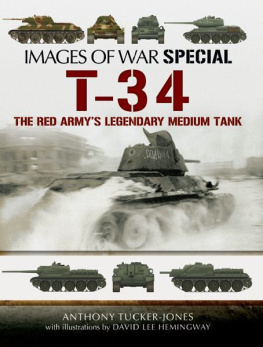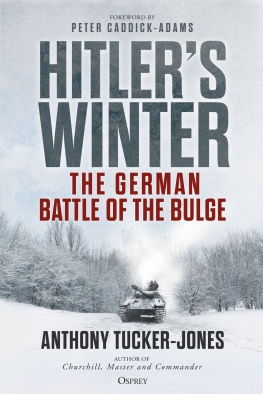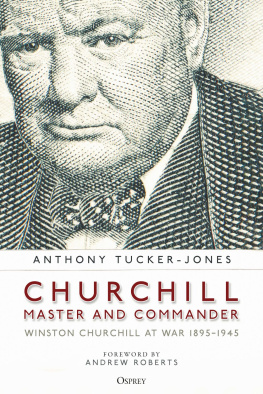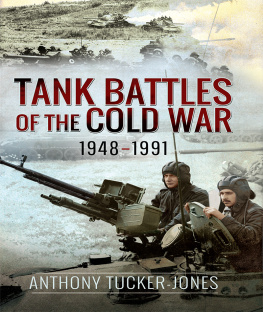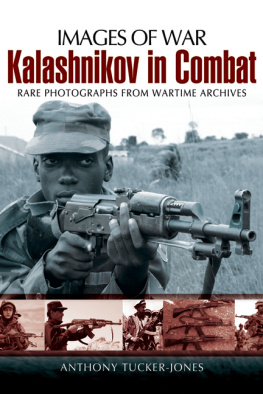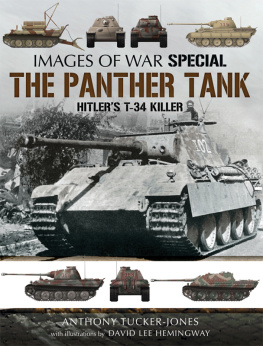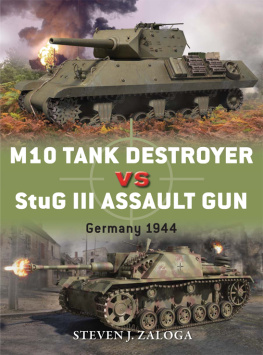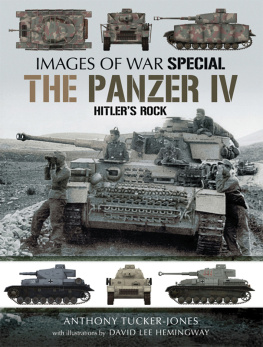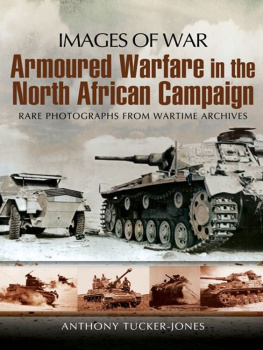
First published in Great Britain in 2015 by
PEN & SWORD MILITARY
an imprint of
Pen & Sword Books Ltd,
47 Church Street,
Barnsley,
South Yorkshire
S70 2AS
Text copyright Pen & Sword Books 2015
Photographs copyright as credited 2015
ISBN: 978 178159 095 9
EPUB ISBN: 978 147385 446 8
PRC ISBN: 978 147385 458 1
The right of Anthony Tucker-Jones to be identified as Author of this Work
has been asserted by him in accordance with the Copyright, Designs and
Patents Act 1988.
A CIP record for this book is available from the British Library.
All rights reserved. No part of this book may be reproduced or transmitted
in any form or by any means, electronic or mechanical including
photocopying, recording or by any information storage and retrieval system,
without permission from the Publisher in writing.
Typeset by CHIC GRAPHICS
Printed and bound by Gutenberg Press
Pen & Sword Books Ltd incorporates the imprints of Pen & Sword
Archaeology, Atlas, Aviation, Battleground, Discovery, Family History, History,
Maritime, Military, Naval, Politics, Railways, Select, Social History, Transport,
True Crime, and Claymore Press, Frontline Books, Leo Cooper, Praetorian
Press, Remember When, Seaforth Publishing and Wharncliffe.
For a complete list of Pen & Sword titles please contact
Pen & Sword Books Limited
47 Church Street, Barnsley, South Yorkshire, S70 2AS, England
E-mail:
Website: www.pen-and-sword.co.uk
Contents
Introduction
A War Winner
W hen Pen & Sword approached me about producing a pictorial history of the T-34 tank I immediately faced a dilemma: what is there to say about this superb Soviet-designed tank that has not already been said many times before? Then it struck me: the T-34 is the one weapon that truly won the Second World War. A bold statement I grant you, but when one considers the vastness of the Eastern Front the campaigns fought in France, Italy and North Africa and, indeed, in the Far East were just sideshows when it came to armoured warfare. Throughout the Second World War tank designs came and went, but the T-34 was the one constant from 1940 to 1945. After Hitlers invasion of Russia the T-34 became the spearhead of the Red Armys blitzkrieg that took it from Stalingrad and Kursk to the very heart of Berlin and victory over the Nazis.
Following the German invasion the Red Army floundered around, its forces in disarray no matter how many counterattacks it launched. Fortunately, though, its tank factories had been saved, which meant the T-34 began appearing in ever-greater numbers. Then, at the end of 1942, the Red Armys new tank armies, equipped with the T-34, played a key role in shattering the German, Italian, Hungarian and Romanian lines at Stalingrad. The following summer the T-34 sent Hitlers panzers reeling at Kursk.
Designing a tank is a simple compromise between speed, weight, armour and armament. Get the combination right and it gives you a winning edge; get it wrong and it ends in disaster. Most early Soviet tanks opted for speed as they were regarded as little more than armoured cavalry designed to charge through the enemys lines in support of the infantry. The dominance of cavalry officers in the Red Army after the Russian Civil War was largely responsible for this mindset. At the same time the Red Army was struggling to learn the most effective ways to employ their ever-growing numbers of tanks. In the summer of 1941 all of Russias light, medium and heavy tank designs proved an unmitigated disaster in the face of Hitlers panzers and superior German strategy. Only after a very shaky start did one new tank catch the eye of the Red Armys generals the T-34/76. It also caught the eye of the German generals.
While the T-34 had a number of innovative design advantages over its competitors, one in particular stands out. The critical problem faced by the British Churchill and Cromwell, the American Sherman and the German Panzer Mk IV and Panther was that they could not be upgunned beyond a 76mm/77mm calibre gun. The hulls of these tanks would simply not permit a larger turret and therefore a larger anti-tank gun. This greatly limited their tank-killing capabilities. The Allies never really overcame this shortcoming until the advent of the Pershing tank armed with a 90mm gun and by then the war was all but over. The Germans got round this limitation by producing higher-velocity 75mm guns and the Tiger I and II armed with an 88mm gun, but the Tigers were only made in relatively limited numbers.
In contrast, the squat hull of the T-34/76 enabled the Soviets to conduct a significant enhancement by the simple expedient of fitting a much larger cast turret that could house a much bigger gun namely an 85mm high-velocity anti-aircraft gun redesigned as an anti-tank weapon. The resulting T-34/85 may not have given the Red Army battlefield dominance, but it certainly gave them much-needed parity with the later panzers. This, coupled with the T-34s vast numbers, was a war-winning combination. The T-34s design ensured that not only was it easy to build but, just as importantly, it was easy to maintain on the battlefield regardless of the weather.
While the Allies and the Germans enjoyed success with a range of tank destroyers and assault guns, those T-34s converted to the assault gun role proved far less satisfactory. The British and Americans armed some Shermans with 76mm and 77mm guns, but these were very few in number and did not make up for the Shermans poor armour. Likewise the Sherman-based Achilles/Wolverine tank destroyer faced the same problem. It was in trying to replicate the German Sturmgeschtz or assault gun concept that the T-34 came a cropper, its tank-destroyer variants proving little more than a stopgap until the heavy KV tank chassis married to a 152mm howitzer produced a really invincible tank killer. Only the T-34-based SU-100 tank destroyer provided the additional punch that the T-34/85 lacked.
It was Soviet experiences in Spain that led indirectly to the T-34s development, which eventually gave them an important technological edge over the Germans. In the wake of the Spanish Civil War many experts concluded that the anti-tank gun was more effective than the tank, and the rudimentary mechanised combat in Spain refuted the new theories about mechanised warfare. They failed to take into account the unsuitable terrain, the poorly trained crews and the relatively small numbers of tanks employed.
General Dimitri Pavlov, a Soviet tank specialist who served in Spain and was one of the innovators of Soviet mechanisation during the early 1930s, had observed the increased use and accuracy of anti-tank weapons. Both the BT-5 and T-26 suffered a gradual reduction in armour effectiveness and this led the Soviet Union to ensure that its tanks not only were resistant to shell splinters and small arms, but could also withstand direct hits from small-calibre artillery.
Ironically, Pavlovs experiences in Spain would ultimately cost him his life, for he drew the wrong conclusions about the deployment of armour. He advocated the French doctrine whereby tanks were used in direct support of the infantry. He felt that the doctrine of blitzkrieg by mass armour was not sound. On returning to Russia in 1939, he argued in favour of disbanding the unwieldy Soviet tank corps.
Just months before Hitlers attack, senior Soviet commanders attended a key conference followed by war games during December 1940 and January 1941. There was then a gathering in the Kremlin, the last of its sort before the German invasion. The aim was to assess the progress made by the armed forces following the war with Finland and Hitlers blitzkrieg victories in Europe. Some commanders still advocated the horse over the tank and crucially Stalin, while he defended the tank, made no executive decision about the future of the Soviet armoured forces.
Next page
